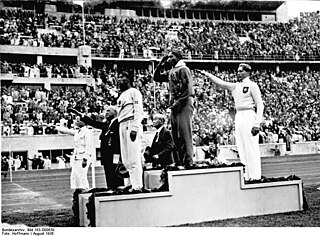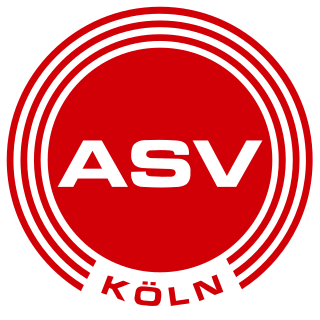
Karl Schelenz (or Carl Schelenz, born 6 February 1890 in Berlin; died 7 February 1956) was a German sports teacher. He is famous as the "father" of modern handball.

Karl Schelenz (or Carl Schelenz, born 6 February 1890 in Berlin; died 7 February 1956) was a German sports teacher. He is famous as the "father" of modern handball.
Schelenz worked as a sports teacher in Berlin and in Flensburg. As an author, he wrote books on the modern sport of handball. In 1917 he, Erich Konigh, and Max Heiser published the first modern set of rules for handball [1] on 29 October in Berlin, which is seen as the date of birth of the sport. [2] [3] Schelenz modified the rules in 1919. [1]
In 1916 and in 1917, he was the German champion in long jump. [4] He was third in the German championship in high jump. Schelenz was a member of the German sport team Berliner Turner-Verein von 1850 e. V. in Berlin. [5]

Carl Ludwig "Luz" Long was a German Olympic long jumper who won the silver medal in the event at the 1936 Summer Olympics in Berlin and had a friendship with Jesse Owens, who won the gold medal in that event. Luz Long won the German long jump championship six times: in 1933, 1934, 1936, 1937, 1938, and 1939.

Ernst Gustav Kraatz was a German entomologist. He collected and described numerous beetles including Staphylinidae. Kraatz was a founding member of the Berlin Entomological Club and the German entomological society and the first editor of its journal, the Deutsche Entomologische Zeitschrift. Kraatz was involved in improving the standards of taxonomic description in German entomology and he was a proponent of a national collection that allowed public access to specimens.
The Verein für Socialpolitik, or the German Economic Association, is an important society of economists in the German-speaking area.
Ice hockey in Germany is one of the more popular sports, and ranks behind Handball and football in spectator favour and meaning. Ice hockey is organized today in Germany by the Deutsche Eishockey Liga, the highest professional league, and by the Deutschen Eishockey-Bund ice hockey federation, which is the sport's federation in Germany and a member of the International Ice Hockey Federation.
Carl Wilhelm, was a prolific German film director, film producer and screenwriter of the silent film era, at the end of which his career apparently entirely faded away and he vanished into obscurity.

Katharina "Käthe" Anna Krauß was a German track and field athlete, who won three gold medals at the 1934 Women's World Games in London and a bronze medal in the 100 metres at the 1936 Summer Olympics in Berlin, where she was also on the German 4 × 100 m relay team. She won several German championships in various events and 2 silver medals and a gold medal in the 4 × 100 m relay at the 1938 European Athletics Championships in Vienna.
Since the 18th century Berlin has been an influential musical center in Germany and Europe. First as an important trading city in the Hanseatic League, then as the capital of the electorate of Brandenburg and the Prussian Kingdom, later on as one of the biggest cities in Germany it fostered an influential music culture that remains vital until today. Berlin can be regarded as the breeding ground for the powerful choir movement that played such an important role in the broad socialization of music in Germany during the 19th century.
Giuseppe Becce was an Italian-born film score composer who enriched the German cinema.
Max Gaede was a German engineer and entomologist of international fame who described several hundred of new species of Lepidoptera, mainly African Noctuidae.
Braunschweiger MTV von 1847, commonly known as MTV Braunschweig, is a German sports club based in Braunschweig, Lower Saxony.

Athletik-Sport-Verein Köln e.V. is a multi-sports club from Cologne, Germany. It has sections for rugby union, athletics, triathlon and karate
Carl Schmidt was a German Coptologist. He made editions of various Coptic texts, and was active in Egypt in purchasing papyri for German universities. He also assisted Sir Chester Beatty in his papyri purchases.

Adolph Kohut was a German-Hungarian journalist, literature and cultural historian, biographer, recitator and translator from Hungarian origin.
Karl Gaillard was a Prussian writer and music journalist.

Große Berliner Kunstausstellung , abbreviated GroBeKa or GBK, was an annual art exhibition that existed from 1893 to 1969 with intermittent breaks. In 1917 and 1918, during World War I, it was not held in Berlin but in Düsseldorf. In 1919 and 1920, it operated under the name Kunstausstellung Berlin. From 1970 to 1995, the Freie Berliner Kunstausstellung was held annually in its place.

Karl Heinrich Helmerding was a German folk actor and was considered the most popular comedian of all time in Berlin.
Karl Hermann Joseph Hubert Hilgers was a German sculptor.
Max Creutz was a German art historian and curator of the Museum für Angewandte Kunst Köln and the Kaiser-Wilhelm-Museum in Krefeld where he worked from 1922 until his death. In Cologne, in 1914 he was instrumental in the first exhibition of the Deutscher Werkbund, Deutsche Werkbundausstellung. In Krefeld, he succeeded in acquiring modern art exhibits, including works by Max Ernst, Wassily Kandinsky, and Alexej von Jawlensky. He included a substantial collection of art, crafts and design from the Bauhaus.

Karl Scheffler was a German art critic and publicist.

Max Ring was a German physician, novelist, poet, and dramatist.